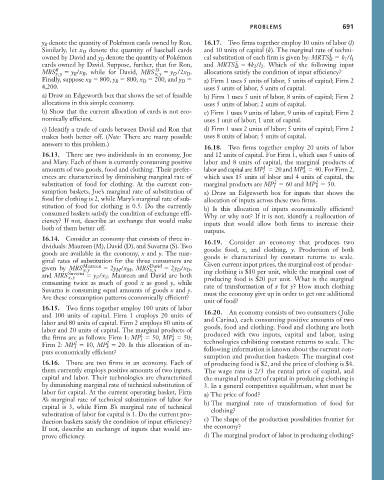Page 717 - Microeconomics, Fourth Edition
P. 717
c16GeneralEquilibriumTheory.qxd 8/16/10 9:14 PM Page 691
PROBLEMS 691
y R denote the quantity of Pokémon cards owned by Ron. 16.17. Two firms together employ 10 units of labor (l)
Similarly, let x D denote the quantity of baseball cards and 10 units of capital (k). The marginal rate of techni-
1
owned by David and y D denote the quantity of Pokémon cal substitution of each firm is given by: MRTS lk k 1 /l 1
2
cards owned by David. Suppose, further, that for Ron, and MRTS lk 4k 2 /l 2 . Which of the following input
D
R
MRS x, y y R /x R , while for David, MRS x, y y D /2x D . allocations satisfy the condition of input efficiency?
Finally, suppose x R 800, y R 800, x D 200, and y D a) Firm 1 uses 5 units of labor, 5 units of capital; Firm 2
4,200. uses 5 units of labor, 5 units of capital.
a) Draw an Edgeworth box that shows the set of feasible b) Firm 1 uses 5 unit of labor, 8 units of capital; Firm 2
allocations in this simple economy. uses 5 units of labor; 2 units of capital.
b) Show that the current allocation of cards is not eco- c) Firm 1 uses 9 units of labor, 9 units of capital; Firm 2
nomically efficient. uses 1 unit of labor; 1 unit of capital.
c) Identify a trade of cards between David and Ron that d) Firm 1 uses 2 units of labor; 5 units of capital; Firm 2
makes both better off. (Note: There are many possible uses 8 units of labor; 5 units of capital.
answers to this problem.)
16.18. Two firms together employ 20 units of labor
16.13. There are two individuals in an economy, Joe and 12 units of capital. For Firm 1, which uses 5 units of
and Mary. Each of them is currently consuming positive labor and 8 units of capital, the marginal products of
1
1
amounts of two goods, food and clothing. Their prefer- labor and capital are MP l 20 and MP k 40. For Firm 2,
ences are characterized by diminishing marginal rate of which uses 15 units of labor and 4 units of capital, the
2
2
substitution of food for clothing. At the current con- marginal products are MP l 60 and MP k 30.
sumption baskets, Joe’s marginal rate of substitution of a) Draw an Edgeworth box for inputs that shows the
food for clothing is 2, while Mary’s marginal rate of sub- allocation of inputs across these two firms.
stitution of food for clothing is 0.5. Do the currently b) Is this allocation of inputs economically efficient?
consumed baskets satisfy the condition of exchange effi- Why or why not? If it is not, identify a reallocation of
ciency? If not, describe an exchange that would make inputs that would allow both firms to increase their
both of them better off. outputs.
16.14. Consider an economy that consists of three in- 16.19. Consider an economy that produces two
dividuals: Maureen (M), David (D), and Suvarna (S). Two goods: food, x, and clothing, y. Production of both
goods are available in the economy, x and y. The mar- goods is characterized by constant returns to scale.
ginal rates of substitution for the three consumers are
Maureen David Given current input prices, the marginal cost of produc-
given by MRS x, y 2y M /x M , MRS x, y 2y D /x D , ing clothing is $10 per unit, while the marginal cost of
Suvarna
and MRS x, y y S /x S . Maureen and David are both producing food is $20 per unit. What is the marginal
consuming twice as much of good x as good y, while rate of transformation of x for y? How much clothing
Suvarna is consuming equal amounts of goods x and y. must the economy give up in order to get one additional
Are these consumption patterns economically efficient?
unit of food?
16.15. Two firms together employ 100 units of labor
and 100 units of capital. Firm 1 employs 20 units of 16.20. An economy consists of two consumers ( Julie
labor and 80 units of capital. Firm 2 employs 80 units of and Carina), each consuming positive amounts of two
labor and 20 units of capital. The marginal products of goods, food and clothing. Food and clothing are both
1
1
the firms are as follows: Firm 1: MP l 50, MP k 50; produced with two inputs, capital and labor, using
2
2
Firm 2: MP l 10, MP k 20. Is this allocation of in- technologies exhibiting constant returns to scale. The
puts economically efficient? following information is known about the current con-
sumption and production baskets: The marginal cost
16.16. There are two firms in an economy. Each of of producing food is $2, and the price of clothing is $4.
them currently employs positive amounts of two inputs, The wage rate is 2/3 the rental price of capital, and
capital and labor. Their technologies are characterized the marginal product of capital in producing clothing is
by diminishing marginal rate of technical substitution of 3. In a general competitive equilibrium, what must be
labor for capital. At the current operating basket, Firm a) The price of food?
A’s marginal rate of technical substitution of labor for b) The marginal rate of transformation of food for
capital is 3, while Firm B’s marginal rate of technical clothing?
substitution of labor for capital is 1. Do the current pro-
duction baskets satisfy the condition of input efficiency? c) The shape of the production possibilities frontier for
If not, describe an exchange of inputs that would im- the economy?
prove efficiency. d) The marginal product of labor in producing clothing?

